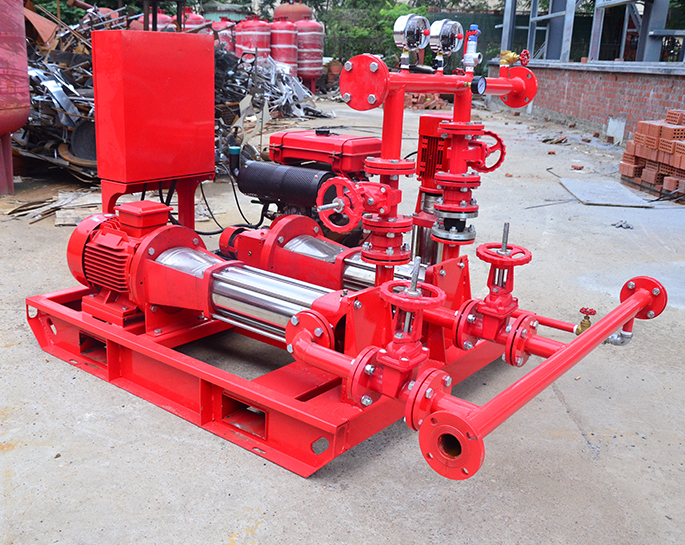What are the key factors to consider when selecting a fire pump set?
Feb 27, 2024
Share:
When selecting a fire pump set, several key factors need to be considered to ensure that it meets the specific requirements of the application and complies with relevant regulations. Here are some of the essential factors to consider:
1. **Flow Rate and Pressure Requirements**: Determine the required flow rate (in gallons per minute or liters per second) and pressure (in pounds per square inch or bars) based on the size and type of the building or area to be protected. This information will help in selecting a fire pump set with the appropriate capacity to meet the demand.
2. **Type of Fire Protection System**: Consider the type of fire protection system being used, such as a sprinkler system, standpipe system, or fire hydrant system. Different systems may have varying requirements for flow rate, pressure, and pump configuration.
3. **Power Source**: Decide whether the fire pump set will be powered by electricity, diesel, or another fuel source. The choice of power source will depend on factors such as availability, reliability, and any specific regulations or codes governing fire pump installations in your area.
4. **Pump Type**: Choose the appropriate type of pump based on factors such as the water source (e.g., static water supply, reservoir, or municipal water system), suction lift requirements, and efficiency considerations. Common pump types include centrifugal pumps, vertical turbine pumps, and positive displacement pumps.
5. **System Redundancy and Reliability**: Evaluate the reliability of the fire pump set and consider incorporating redundancy features such as multiple pumps or backup power sources to ensure continuous operation during emergencies or maintenance.
6. **Compliance with Standards and Codes**: Ensure that the fire pump set complies with relevant industry standards and codes, such as NFPA 20 (Standard for the Installation of Stationary Pumps for Fire Protection) and local building and fire codes. Compliance with these standards is essential for safety and regulatory compliance.
7. **Environmental Conditions**: Take into account environmental factors such as temperature, humidity, and corrosive conditions that may affect the performance and longevity of the fire pump set. Select materials and components that are suitable for the prevailing environmental conditions.
8. **Installation and Maintenance Requirements**: Consider the installation space, accessibility for maintenance, and any specific maintenance requirements of the fire pump set. Adequate space, proper ventilation, and ease of access for servicing are crucial for ensuring optimal performance and longevity.
By carefully considering these factors and consulting with fire protection engineers or experts, you can select a fire pump set that meets the specific needs of your application and provides reliable fire protection.

1. **Flow Rate and Pressure Requirements**: Determine the required flow rate (in gallons per minute or liters per second) and pressure (in pounds per square inch or bars) based on the size and type of the building or area to be protected. This information will help in selecting a fire pump set with the appropriate capacity to meet the demand.
2. **Type of Fire Protection System**: Consider the type of fire protection system being used, such as a sprinkler system, standpipe system, or fire hydrant system. Different systems may have varying requirements for flow rate, pressure, and pump configuration.
3. **Power Source**: Decide whether the fire pump set will be powered by electricity, diesel, or another fuel source. The choice of power source will depend on factors such as availability, reliability, and any specific regulations or codes governing fire pump installations in your area.
4. **Pump Type**: Choose the appropriate type of pump based on factors such as the water source (e.g., static water supply, reservoir, or municipal water system), suction lift requirements, and efficiency considerations. Common pump types include centrifugal pumps, vertical turbine pumps, and positive displacement pumps.
5. **System Redundancy and Reliability**: Evaluate the reliability of the fire pump set and consider incorporating redundancy features such as multiple pumps or backup power sources to ensure continuous operation during emergencies or maintenance.
6. **Compliance with Standards and Codes**: Ensure that the fire pump set complies with relevant industry standards and codes, such as NFPA 20 (Standard for the Installation of Stationary Pumps for Fire Protection) and local building and fire codes. Compliance with these standards is essential for safety and regulatory compliance.
7. **Environmental Conditions**: Take into account environmental factors such as temperature, humidity, and corrosive conditions that may affect the performance and longevity of the fire pump set. Select materials and components that are suitable for the prevailing environmental conditions.
8. **Installation and Maintenance Requirements**: Consider the installation space, accessibility for maintenance, and any specific maintenance requirements of the fire pump set. Adequate space, proper ventilation, and ease of access for servicing are crucial for ensuring optimal performance and longevity.
By carefully considering these factors and consulting with fire protection engineers or experts, you can select a fire pump set that meets the specific needs of your application and provides reliable fire protection.







